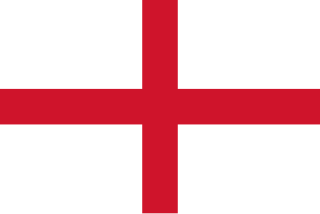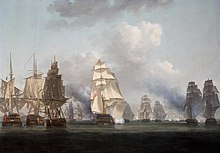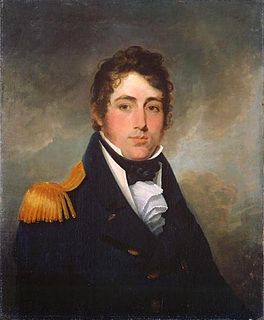
Admiral of the Fleet Sir Provo William Parry Wallis, was a Royal Navy officer. As a junior officer, following the capture of USS Chesapeake by the frigate HMS Shannon during the War of 1812, the wounding of HMS Shannon's captain and the death of her first lieutenant in the action, he served as the temporary captain of HMS Shannon for a period of exactly six days as she made her way back to Halifax, Nova Scotia, with Chesapeake flying the Blue Ensign above the Stars and Stripes.
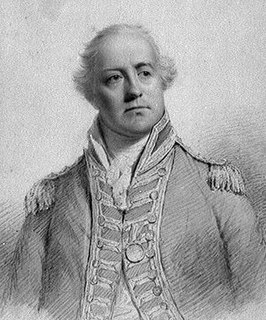
Admiral of the Fleet James Gambier, 1st Baron Gambier, was a Royal Navy officer. After seeing action at the capture of Charleston during the American Revolutionary War, he saw action again, as captain of the third-rate HMS Defence, at the battle of the Glorious First of June in 1794, during the French Revolutionary Wars, gaining the distinction of commanding the first ship to break through the enemy line.

Admiral of the Fleet Sir George Cockburn, 10th Baronet, was a Royal Navy officer. As a captain he was present at the Battle of Cape St Vincent in February 1797 during the French Revolutionary Wars and commanded the naval support at the reduction of Martinique in February 1809 during the Napoleonic Wars. He also directed the capture and Burning of Washington on 24 August 1814 as an advisor to Major General Robert Ross during the War of 1812. He went on to be First Naval Lord and in that capacity sought to improve the standards of gunnery in the fleet, forming a gunnery school at Portsmouth; later he ensured that the Navy had latest steam and screw technology and put emphasis of the ability to manage seamen without the need to resort to physical punishment.
Rear-Admiral Sir Edward Thomas Troubridge, 2nd Baronet, was an officer of the British Royal Navy who served in the French Revolutionary, Napoleonic and War of 1812. He later served for fifteen years as the member of parliament for Sandwich, Kent.

Admiral Sir James Whitley Deans Dundas GCB was a Royal Navy officer. He took part in the Napoleonic Wars, first as a junior officer when he took part in the Anglo-Russian invasion of Holland in Autumn 1799 and later as a commander when he was in action at Copenhagen Dockyard shortly after the capture of that City in August 1807. He also served as Whig Member of Parliament for Greenwich and then for Devizes and became First Naval Lord in the First Russell ministry in July 1847 and in that role his service was dominated by the needs of Whig party. He was appointed Commander-in-Chief in the Mediterranean in 1852 and led all naval operations in the Black Sea including the bombardment of Sevastopol in October 1854 during the Crimean War.
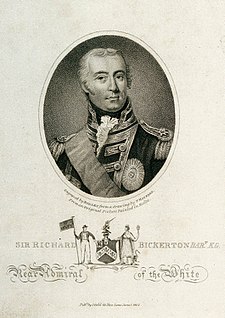
Admiral Sir Richard Hussey Bickerton, 2nd Baronet, KCB, was a British naval officer. He was born in Southampton, the son of Vice-admiral Sir Richard Bickerton and first served aboard HMS Medway in June 1774, in the Mediterranean. His first command came in March 1779 when he was given HM Sloop Swallow as a reward for his part in an engagement with a much larger opponent. Bickerton later joined Rodney's squadron in the West Indies where he took part in the capture of Sint Eustatius in 1781. Making post captain on 8 February 1781, he took temporary command of HMS Invincible and fought in her at the Battle of Fort Royal on 29 April 1781.

Admiral of the Fleet Sir Edward Beckwith Ashmore, was a senior Royal Navy officer. He saw active service in the Second World War and later commanded two frigates before achieving high command in the Navy. He served as First Sea Lord and Chief of the Naval Staff in the mid-1970s and in that role he advised the incoming Labour government on a major defence review and on the implications of the Turkish invasion of Cyprus. He went on to be Chief of the Defence Staff, serving briefly in a caretaker capacity following the death of his predecessor.

Admiral of the Fleet Sir Charles Morice Pole, 1st Baronet GCB was a Royal Navy officer and colonial governor. As a junior officer he saw action at the Siege of Pondicherry in India during the American Revolutionary War. After taking command of the fifth-rate HMS Success he captured and then destroyed the Spanish frigate Santa Catalina in the Strait of Gibraltar in the action of 16 March 1782 later in that War.

Admiral of the Fleet Sir William Parker, 1st Baronet, GCB, was a Royal Navy officer. As a captain's servant he took part in the Battle of The Glorious First of June in June 1794 during the French Revolutionary Wars and, as a captain, he participated in the capture of the French ships Marengo and Belle Poule at the Action of 13 March 1806 during the Napoleonic Wars. He was detached on an independent command on the Tagus in September 1831 with a mission to protect British interests during the Portuguese Civil War. As Commander-in-chief of the East Indies and China Station, he provided naval support at various actions between 1841 and 1842 during the First Opium War. Appointed Commander-in-Chief, Mediterranean Fleet in February 1845, he was briefly First Naval Lord in the First Russell ministry from 13 July 1846 to 24 July 1846 but gave up the role due to ill health before returning to his command with the Mediterranean Fleet.

Vice-Admiral The Honourable Sir Henry Hotham was officer of the British Royal Navy who served during the French Revolutionary, Napoleonic Wars, and the War of 1812, was later a member of the Board of Admiralty, and ended his career as Commander-in-Chief of the Mediterranean Fleet.
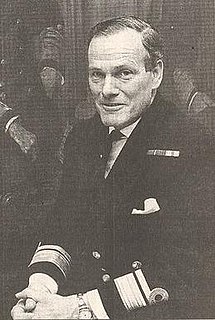
Admiral of the Fleet Sir William Doveton Minet Staveley was a Royal Navy officer. Staveley saw service as a minesweeper commander on coastal patrol during the Indonesia–Malaysia confrontation before commanding a frigate and then an aircraft carrier and ultimately achieving higher command in the Navy. He served as First Sea Lord and Chief of Naval Staff in the late 1980s. In that role he fought hard for a fleet large enough to meet NATO commitments.

Admiral Sir Sydney Colpoys Dacres was an officer of the Royal Navy who saw service during the Greek War of Independence, when he was involved in an attack on the Turkish forces at Morea, and later during the Crimean War. Born into a substantial naval dynasty during the Napoleonic Wars, he eventually rose to the rank of Admiral and became First Naval Lord. His only significant action as First Naval Lord was to press for the abolition of masts. He went on to be Visitor and Governor of Greenwich Hospital.

Admiral of the Fleet Sir William Henry May was a Royal Navy Officer. As a junior officer he took part an expedition to rescue Commander Albert Markham who had got into difficulty trying to reach the North Pole via Smith Sound, the sea passage between Greenland and Canada's northernmost island, Ellesmere Island.
Captain Sir Charles Marsh Schomberg was an officer of the British Royal Navy, who served during French Revolutionary and Napoleonic Wars, and later served as Lieutenant-Governor of Dominica.

Admiral of the Fleet Sir Graham Eden Hamond, 2nd Baronet, was a Royal Navy officer. After seeing action as a junior officer at the Glorious First of June and then at the Battle of Toulon, he commanded the fifth-rate HMS Blanche at the Battle of Copenhagen during the French Revolutionary Wars.

Vice Admiral Sir William Johnstone Hope, GCB was a prominent and controversial British Royal Navy officer and politician in late eighteenth and early nineteenth century Britain, whose career experienced fleet actions, disputes with royalty, party politics and entry to both Russian and British orders of chivalry. A popular officer, Hope served with Nelson, Duncan and Lord Keith through several campaigns, making connections which enabled him to secure a lengthy political career after his retirement from the Royal Navy in 1804 due to ill-health. After 26 years in Parliament, Hope was largely inactive and instead served as a Lord of the Admiralty and commissioner of Greenwich Naval Hospital. Hope died in 1832 after 55 years of naval and political service and was buried in the family plot in Scotland.
Sir Richard John Strachan, 6th Baronet GCB was a British officer of the Royal Navy during the French Revolutionary and Napoleonic Wars, eventually rising to the rank of admiral. Sir Dicky, as his friends referred to him, was the last Chief of Clan Strachan. The Baronetcy became dormant in 1854 as he died without male heir.
Admiral Hugh Pigot, of Wychwood Forest in Oxfordshire, was a Royal Navy officer. He commanded York at the reduction of Louisbourg in June 1758 and commanded Royal William at the capture of Quebec in September 1759 during the Seven Years' War. He went on to serve as Commander-in-Chief of the Leeward Islands Station during the American Revolutionary War and then became First Naval Lord. He also served as a Member of Parliament.
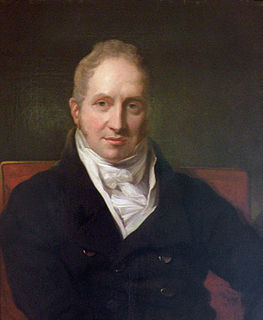
Admiral of the Fleet Sir Houston Stewart, was a Royal Navy officer and briefly a Liberal Party Member of Parliament. After serving as a junior officer in the Napoleonic Wars, Stewart became commanding officer of the third-rate HMS Benbow in the Mediterranean Fleet and took part in the bombardment of Acre during the Egyptian–Ottoman War. He went on to be Captain-Superintendent of Woolwich Dockyard and then Controller-General of the Coastguard.

Admiral Sir Arthur William Moore, was a Royal Navy officer who went on to command the China Station and to serve as Commander-in-Chief, Portsmouth.
